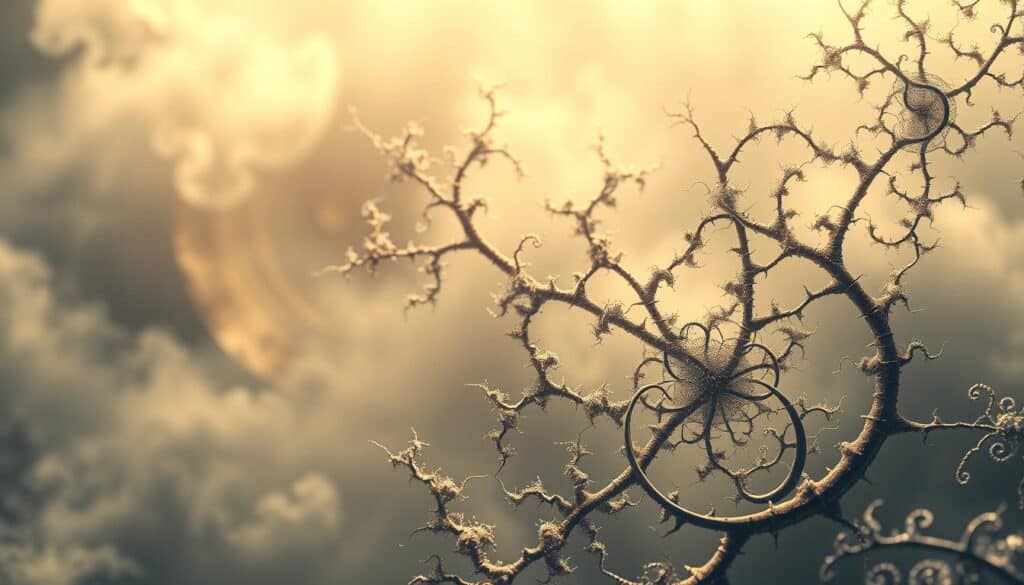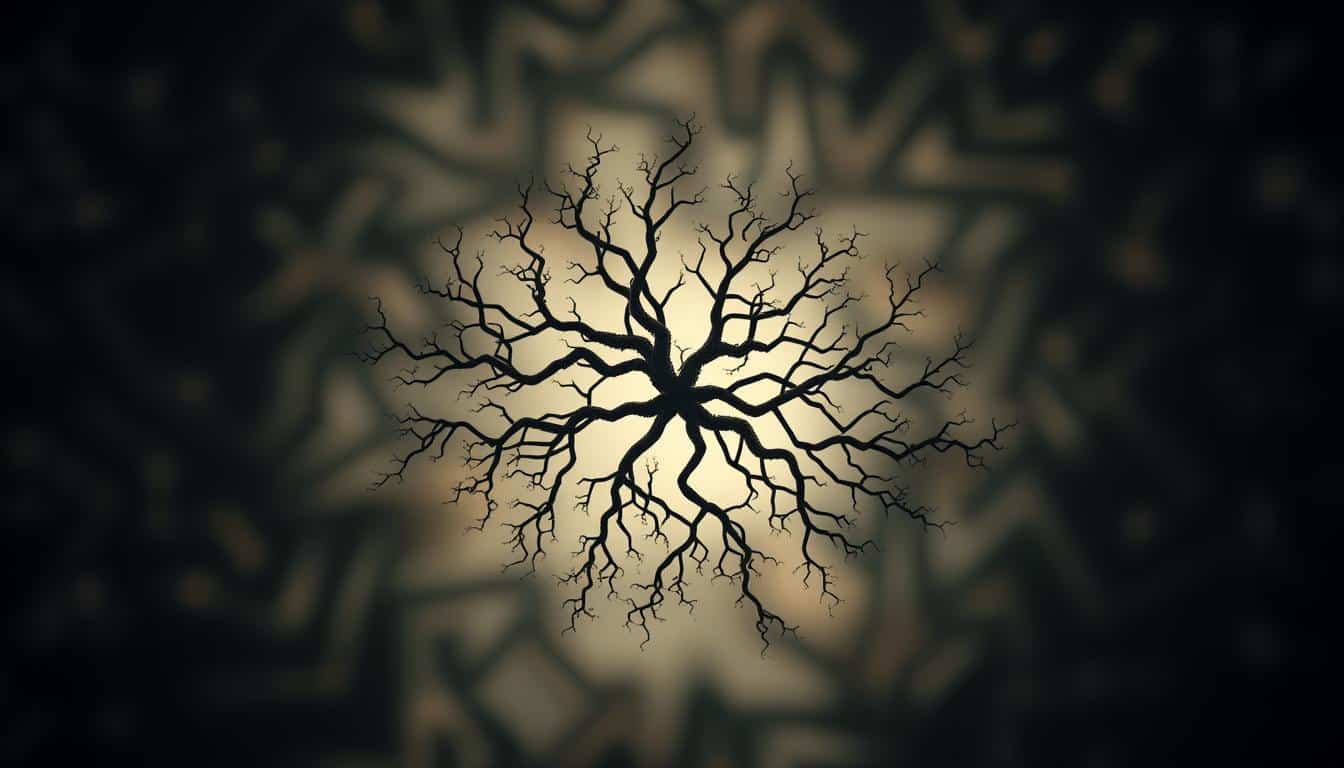Exploring human experience brings us to the intriguing intersection of fractals and consciousness. Fractals are mathematical forms with repeating patterns. They shed light on the mind-body connection. As we dive deeper into consciousness research, we wonder. How does fractalization help explain the mind? It also mirrors our life’s complexity. This piece will explore key questions in this area. It aims to clarify the puzzles of our conscious life.
The Intersection of Fractals and Consciousness
Fractals and consciousness together offer a vast area for study. Fractal theory shows that patterns repeat at different scales. This is similar to what we see in our thinking processes. It shows that both share self-similar qualities. This helps us see consciousness as something with many layers.
In consciousness studies, the fractal nature of our awareness stands out. It makes us see our experiences as connected. Every thought or feeling is like a fractal. It grows and changes but keeps its basic pattern in different situations.

Math and philosophy bring their insights to this topic. They help us see consciousness in many dimensions. Recognizing consciousness as fractal might change how we understand the mind and body. It could also deepen our understanding of our own experiences and those we share with others.
Understanding Fractals: Definitions and Significance
Fractals show complex patterns that look alike across different scales. The idea of fractals grew from thinkers like Benoit Mandelbrot. He named them and found how they fit in many fields. Fractals are key in computer graphics, studying nature, and looking at life’s systems.
When we study fractal geometry, we see patterns in the natural world. Coastlines, mountains, and trees have fractal features. Fractals help scientists understand nature’s complexity. They use fractals to model things that simple math can’t. Through fractals, we get a new view of the patterns around us.
Fractal geometry makes us see space and shape in new ways. It changes our view of dimensions. It leads us to a deeper sense of connection and life’s complexity. This journey is not just about numbers. It opens ways to see the chaos and beauty in life.
The Connection Between Consciousness and the Brain
The study of consciousness and the brain looks at how they interact. This research shows how our brain activity connects to our conscious experiences. Scientists use new discoveries to understand this link better.
Theories like Baars’ global workspace theory help explain this complex relationship. These ideas tell us that consciousness comes from certain brain patterns. These patterns share information throughout the brain.
Key aspects of this connection include:
- Neural network architecture that influences the dynamics of conscious thought.
- Information processing pathways that facilitate the integration of sensory inputs and subjective experiences.
- The role of synchronized neural activity in establishing a unified conscious experience.
Looking into how the brain creates consciousness is key. This work helps us see how different parts of the brain lead to awareness. Researchers are revealing more about how our brains and consciousness connect.
Fractals and Consciousness: Exploring the Mind-Body Connection
Fractals give us a cool way to look at the mind-body link. They show how our thoughts and the brain’s structure are related. This idea points to our minds and bodies being connected in complex ways, each part affecting the other.
Thinking about how the mind and body work together shows us something amazing. Our thoughts and feelings are like fractals, with patterns that repeat and change. This helps us understand how we see the world and handle our emotions.
By understanding these connections, we learn more about how our minds impact our bodies. And how our physical state influences our thoughts. This two-way relationship highlights the deep bond between our mental and physical health. Recognizing the role of fractals in this can help us take better care of ourselves.
The Role of Fractalization in the Brain
Fractalization is very important in the brain. It helps in forming complex structures for neural activities. The brain’s dendritic trees are examples of this, enabling the brain to process information efficiently. Because of this fractal setup, the brain can integrate different sensory inputs well.
This leads to a deeper understanding of consciousness. Terms like ‘bright matter’ and ‘sentyons’ help explain how fractal designs support our thinking abilities. As these structures grow, our brains get better at handling complex ideas. This shows the strong link between fractalization and how we experience consciousness.
Learning about fractalization in the brain helps us grasp concepts of consciousness. It also points to new ways to tackle brain issues. By studying these structures, scientists can find new methods to improve our cognitive abilities.
Consciousness as a Fractal: Recursive Patterns in Experience
Thinking of consciousness as a fractal opens up a deep look into our experiences. Each moment shines a light on the broader patterns of our awareness. These patterns are like echoes, repeating across different levels of what we perceive.
This idea of fractals in our minds is shown in our thoughts and feelings. It’s like a tapestry, with themes and structures that repeat over time.
Our experiences link together through these patterns. They show how our feelings, thoughts, and what’s around us interact. By noticing these patterns, we can learn more about ourselves and grow.
- Understanding how emotions recur during different life events enhances self-awareness.
- Analyzing recurring thoughts can provide clarity on personal beliefs and values.
- Recognizing shared patterns across experiences fosters empathy and connection with others.
Looking into these recurring patterns can open up new insights. It can improve how we understand and care for our minds. This view lets us see how each experience adds to our overall story, making it richer.
The Illusion of Separation in Conscious Experience
Often, we think we’re separate from others. This notion of separation blurs our view of consciousness’s unity. We fail to see how our experiences link us together. Fractal patterns show us how each person’s consciousness weaves into a bigger picture.
Both philosophy and science teach us to see beyond this illusion. Ancient ideas tell us we’re all part of a larger awareness. Neuroscience shows our brains’ fractal structures, proving our unity.
Understanding we’re connected brings us closer. It makes us choose teamwork over rivalry. By delving into our consciousness’s fractal nature, we see our unity despite our differences.
Neuroscience Perspectives: Dendritic Trees and Fractal Structures
Dendritic trees are a key part of the brain’s anatomy, acting as fractal structures in neuroscience. These complex branches are vital for neural communication and brain connectivity. Basically, they help neurons share and manage information, supporting our cognitive abilities.
Their fractal nature improves how the brain processes information. By growing and splitting, dendrites increase surface area for connections. This boosts learning and memory abilities. Each dendrite can get signals from many neurons, helping to combine information and form crucial neural circuits for thought and behavior.
Recent studies show dendritic trees are vital for how we think and learn. Changes in their structure can affect brain connectivity and our ability to adapt. These fractal designs illustrate the brain’s form and function. They show how neural processes and consciousness are linked. As research continues, we learn more about how dendritic trees shape our minds.
Fractals in Nature: A Reflection of Consciousness
Fractals in nature are beautiful examples of complex patterns like those in our minds. We see these patterns in trees and snowflakes, showing order from chaos. They reveal a deep principle of the universe that connects with our inner experiences.
The spirals in shells and how leaves arrange themselves are not just pretty. They show how nature mirrors our consciousness. Looking at them, we start to see patterns similar to our thoughts and feelings. This helps us enjoy nature more and better understand ourselves.
Nature’s fractals show a bond shared by all life, pointing to our deep connection. When we notice fractals around us, we see our thoughts and feelings reflected back. This suggests our minds work in harmony with the universe’s design.
Implications of the Psychical Loop: A Recurrent Fractal Neural Network
The psychical loop is a unique way to see how consciousness works. It uses a recurrent fractal neural network. This network lets the brain continuously update and integrate information which helps improve how we think.
There are several key outcomes:
- Dynamic Information Flow: Information moves constantly in the psychical loop. This movement makes neural pathways interact a lot.
- Adaptive Learning: The network’s recurrent feature helps in adapting to new learnings and keeping memories.
- Enhanced Consciousness Integration: It is important in making our experiences, thoughts, and feelings more unified, leading to a deeper consciousness.
By looking into how a recurrent fractal neural network functions, we gain insights into mind processes. The psychical loop shows us the intricate ways our cognition works. It allows us to understand the unity of our conscious state from various experiences.
The Expansion and Contraction of Awareness
The dance between growing and shrinking awareness is like looking at fractals. Our consciousness changes, reacting to what’s inside us and what happens around us. This allows us to feel many emotions and explore different thoughts.
As awareness grows, we see and connect more with the world. This helps us create and understand others, making complex things clear. But, when awareness shrinks, we look inward and focus sharply. This is key for making hard choices and deep thinking.
Understanding these shifts in awareness helps us manage our lives better. Whether our consciousness spreads out or narrows down, it enlightens us. Knowing how to use both can make life richer and more satisfying.
Embracing Fractal Awareness in Everyday Life
Fractal awareness can deeply enrich your everyday life. It helps you connect more with yourself and everything around you. Mindfulness and the fractal patterns in consciousness go hand in hand, fostering a fuller experience of life. By noticing these complex patterns, you can feel more united with your emotions and thoughts.
Here are some tips for bringing fractal awareness into your life:
- Engage in regular mindfulness meditation, focusing on your breath and observing how thoughts arise and dissolve like fractals.
- Practice gratitude by noticing the small, repetitive patterns of positivity in your day-to-day life.
- Take nature walks, observing the fractal formations in trees, leaves, and landscapes, thereby connecting with the larger pattern of life.
- Journal your experiences, reflecting on the recurring themes and insights that emerge, illustrating the fractal nature of personal growth.
- Incorporate creative activities, such as drawing or painting, that allow you to explore fractal designs and patterns.
Getting to know and adopt fractal awareness can have healing benefits. People often feel more in tune with themselves and the world. This builds a unity in consciousness. Such practice boosts self-understanding and helps in forming stronger bonds with others. It creates a caring environment for everyone to grow and show empathy.
Conclusion
The study of fractals and consciousness shows a deep link that helps us know the mind-body connection better. This idea highlights how nature’s detailed patterns reflect human awareness’s complexity. Looking into fractals lets us understand the looping nature of experiences, leading to more appreciation of our linked lives.
Through this discussion, we learn that seeing consciousness as a fractal changes personal experiences. It opens opportunities for growth and feeling more united with the world. As our awareness grows and shrinks like fractals, we get to know ourselves and our environment better.
The exploration doesn’t stop here. Going deeper into research and personal work is key to fully understanding consciousness as a fractal. By accepting these findings, we can improve our lives and maybe spark a widespread realization of existence’s fractal traits.



